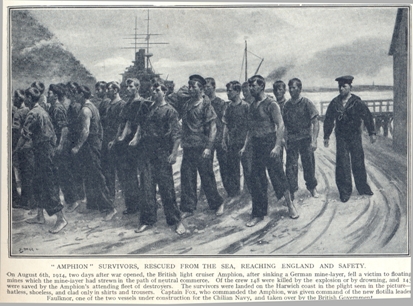HMS Amphion
War between Germany and Britain was declared on August 4th 1914 and the British Expeditionary Force started landing in France on August 7th. The first exchange of fire was at sea and probably the first Cumbrian in action was seaman Fred Robinson, aged 25, of Penrith. He was the son of Tom Robinson, Crown Street, Penrith. Fred was a member of the Royal Naval Reserve and had only left for his ship HMS Amphion on August 3rd. In civilian life he was a wheelwright, employed by Mr Robinson of Castlegate.
On August 5th HMS Amphion found herself on station in the North Sea sweeping with other ships towards the Heligoland Bight. The official press bureau issued the following:-
At 9am on August 5th 1914, HMS Amphion with the 3rd flotilla proceeded to carry out a certain pre-arranged plan of search and about an hour later a trawler informed them that she had seen a suspicious ship 'throwing things overboard' in an indicated position. Shortly afterwards the mine layer Konigen Luise was sighted steering east. Four destroyers gave chase and in about an hour's time she was rounded up and sunk. After rescuing the survivors Amphion continued with the search without further incident until 03:30 of 6 August, when she began the return course to Harwich. Unfortunately the allocated course ran very close to where Königin Luise had laid her mines. At 06:30, Amphion struck a mine that had been previously laid by Königin Luise. A sheet of flame instantly enveloped the bridge which rendered the Captain insensible and he fell on the fore and aft bridge. As soon as he recovered consciousness he ran to the engine room to stop the engines, which were still going at revolutions for 20 knots. As all the forepart was on fire, it proved impossible to reach the bridge or to flood the fore magazine. The ship's back appeared to be broken and she was already settling by the bows.
All efforts were therefore directed to placing the wounded in a place of safety in case of explosion and towards getting her a tow by the stern. By the time destroyers closed in it was clearly time to abandon ship. The men fell in with composure and 20 minutes after the mine struck, the men, officers and captain left their ship.
Three minutes later it exploded. Debris falling from a great height struck the rescue boats, destroyers and one of the Amphion's shells burst on the deck of one of the latter killing two of the men and a German prisoner rescued from the cruiser. After 15 minutes the Amphion had disappeared.
Captain Fox speaks in the highest terms of the behaviour of the men throughout.
Thus, with the war only 32 hours old, HMS Amphion, which had primarily assisted in inflicting the first German Naval loss of the war, became the first British Naval war loss.
151 British lives were lost plus 19 German sailors who had been rescued from the Konigin Luise.
Fred Robinson was one of 143 survivors put ashore at Harwich, hatless, shoeless and clad only in shirts and trousers.


